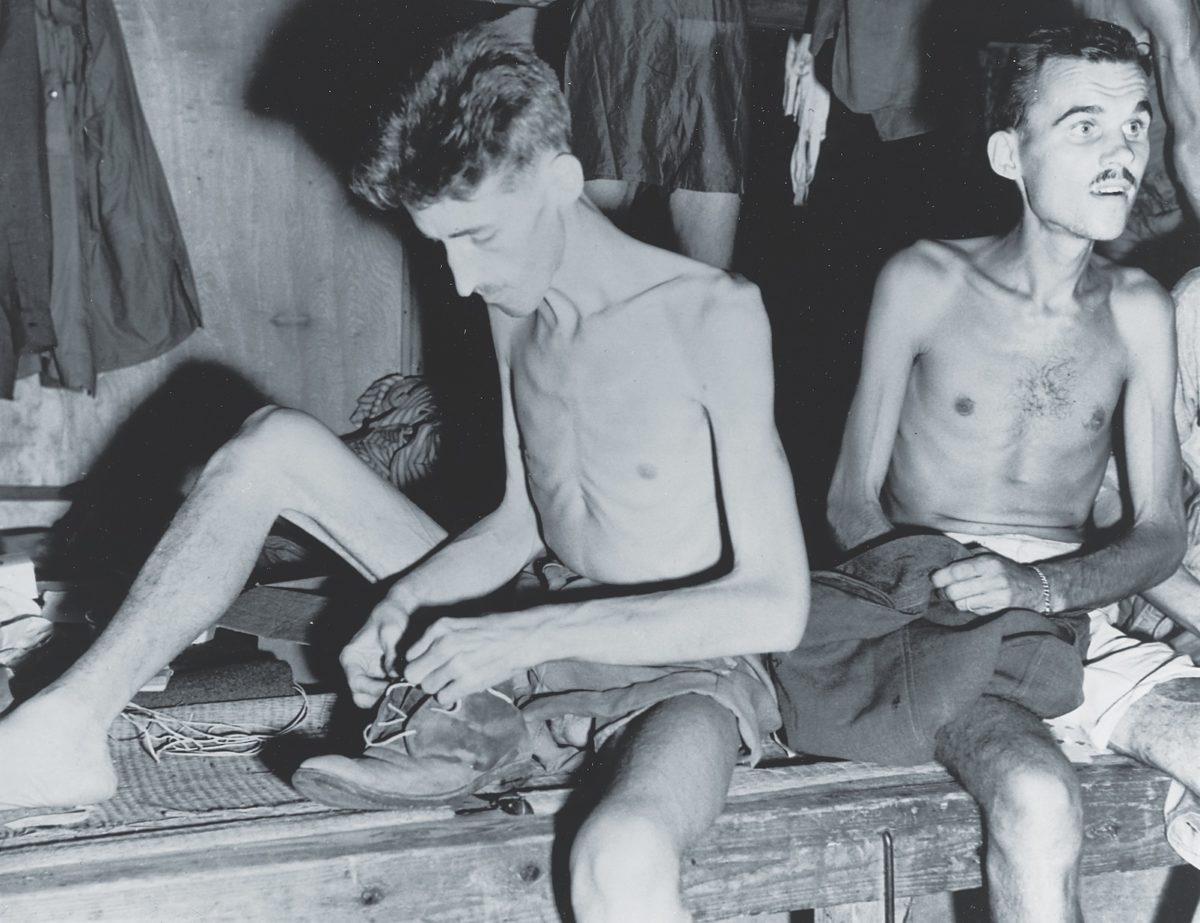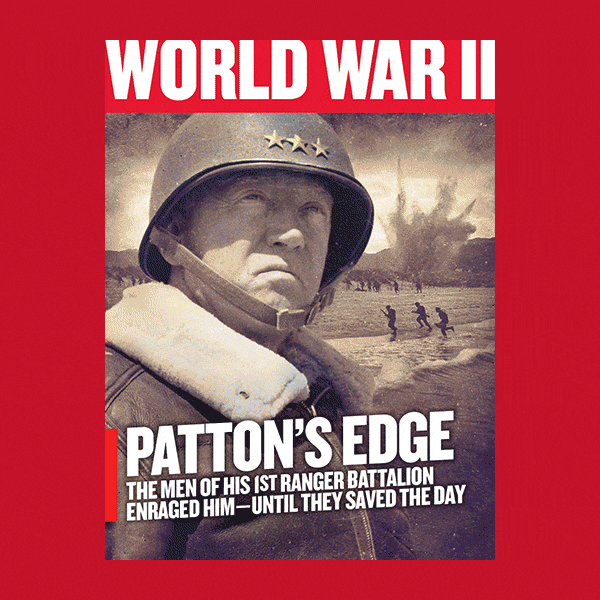Second Lieutenant Thomas C. Cartwright sat on the concrete floor of his solitary cell, wrapped in a threadbare blanket and racked with chills from diarrhea. A single bulb hung from the ceiling, illuminating an otherwise dark, windowless cell with wooden bars. For three days, a pair of Japanese secret policemen—kempeitai—had interrogated the B-24 pilot. They always began with a friendly tone, but their questioning gradually intensified and ended with threats of punishment for “lying.” But the fourth day was different—the kempeitai kept asking about a new, powerful bomb. Cartwright could only shake his head.
Finally, the interrogators stood up in disgust and left, slamming the door behind them. A large soldier appeared in the hallway, brandishing a sword for several long minutes until one of the kempeitai returned. He motioned for Cartwright to rise, tied his hands behind his back, and blindfolded him.
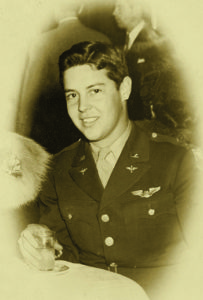
They marched Cartwright down the hallway past other prisoners’ cells and outside onto what he thought was a drill field. He felt the August sun on his face, heard scores of men shuffling around him, and felt their hate coursing at him like a flamethrower’s tongue. Someone pushed him roughly onto his knees and a hand pressed down on his neck, lowering his head. Cartwright heard a sword sliding out of its scabbard. It seemed his luck was finally at an end.
AT 21, TOMMY CARTWRIGHT was the youngest of his crew’s officers—and a natural leader. Born in York, South Carolina, he had teamed up with his older brother in the late 1930s to buy scrap iron that ended up being re-sold to, of all places, Japan. Industrious but not studious, Cartwright was exceptionally self-reliant, hitchhiking across the country after high school to visit his brother in Canada. And although he enjoyed a little mischief now and then—like liberating an ornery army officer’s jeep for a joyride during flight training—he was an otherwise serious young man, and his crew—replacements, like himself—followed his commands without question.
On July 11, 1945, Cartwright and his crew reached their first duty station, Yontan Airfield on Okinawa, 400 miles south of mainland Japan. For replacement crews, missions were few and far between, and Cartwright did not fly his first mission until almost a week later, on July 17. Despite his minimal combat experience, on the morning of his next mission—July 28—Cartwright knew something was up. The briefing room was full of people—far more than the officers slated to fly that day’s mission.
Squadron operations officer Edwin Halter walked to the bulletin board and pulled back the white sheet covering the day’s target. “Kure Harbor,” he said, pointing at the southern end of Honshu, the biggest of Japan’s four main islands. Halter held up a photograph of a Japanese battleship. “This is your target,” he said. “The Haruna.”
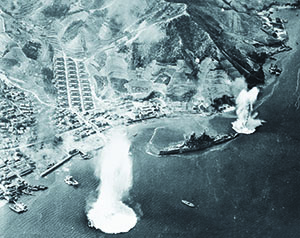
It was quite a prize. The Haruna had fought in almost every major naval action of the Pacific Theater. It supported Japanese troop landings in Malaya in December 1941. A week later, a U.S. Army Air Forces B-17 bomber erroneously reported sinking the Japanese battleship in the Philippines’ Lingayen Gulf. Six months later, the Haruna was involved in the Battles of Midway and Guadalcanal; it also participated in the 1944 Battles of the Philippine Sea and Leyte Gulf. After being slightly damaged in the Battle of the Sibuyan Sea in October, the Haruna ran aground the following month, suffering serious damage. And in early December, the Haruna miraculously evaded several American submarine torpedoes before steaming home for repairs. Five weeks after discovering the battleship at Kure Harbor in February 1945, the U.S. Navy sent carrier aircraft after it—but just one of their bombs struck the Haruna, causing only minor damage. Now, it seemed it was the army’s turn to join in. “I got the distinct impression that the army wanted to ‘beat’ the navy,” Halter later wrote.
Kure Harbor was known to be full of ships, whose firepower would augment the numerous antiaircraft batteries around the harbor. Halter told the pilots that if they were shot down, they were to try to ditch at sea where they had a chance of being rescued by the navy’s PBY patrol aircraft or submarines. “If you bail out over land,” he said. “Turn yourselves in to military personnel. You’ll find no civilian sympathizers.”
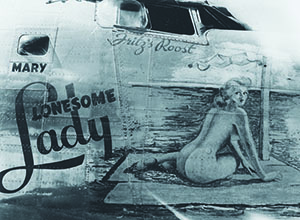
After the briefing, Cartwright, copilot Second Lieutenant Durden W. Looper, navigator Second Lieutenant Roy M. Pedersen, and bombardier Second Lieutenant James M. Ryan walked to the flight line. They were scheduled to fly the B-24 Lonesome Lady, whose nose art—a nude woman adrift on a raft—they had long admired. They and 35 other Liberators would fly in a loose formation, with Lonesome Lady in the number-two position, just behind and to the left of the lead B-24 piloted by Lieutenant Emil Turek.
AS THEY APPROACHED KURE HARBOR at 10,000 feet, Turek spotted the Haruna through broken clouds. Japanese ships and air defense batteries opened fire on the formation. Flak burst all around, the exploding shells’ concussion buffeting the B-24s. Amid heavy fire, each aircraft dropped its three 2,000-lb. bombs. Cartwright’s crew watched in horror as flak hit the B-24 behind them, sending it into a steep dive. They saw only two parachutes bloom before the stricken bomber disappeared into the clouds below. Then a shell tore through Lonesome Lady’s fuselage behind the flight deck and Cartwright’s controls suddenly went sluggish.
Flight engineer Sergeant Buford J. Ellison went to check the damage; he returned soaked in hydraulic fluid. “I hoped to head out to sea before ordering bail-out,” Cartwright recalled. “Then fire broke out and I began losing more control.” With the right inboard engine ablaze, Lonesome Lady began losing altitude. Cartwright saw no other option but to ring the bail-out bell. Looper and he were the last men to escape the B-24, which by then was gyrating wildly in a circling dive. Cartwright dove out the bomb bay, the ground coming toward him fast as he pulled his ripcord. “The shock of the chute opening and popping me tight in the harness and the shock of hitting the ground seemed only seconds apart,” Cartwright said.
He landed in a clearing in a pine forest near the Honshu coast, hid his parachute, and discarded his pistol ammunition so the Japanese could not use it against him. He called out to a farmer who, upon seeing the pistol, dutifully led Cartwright to a police station in the nearby village of Ikachi. There, Cartwright turned his firearm over to the senior-most police officer. The police brought in Durden Looper shortly thereafter, but the angry citizenry, having seen the parachutes drifting earthward, arrived at the station armed with sticks and clubs. One of them stood in the doorway with a pitchfork, as if to prevent their escape.
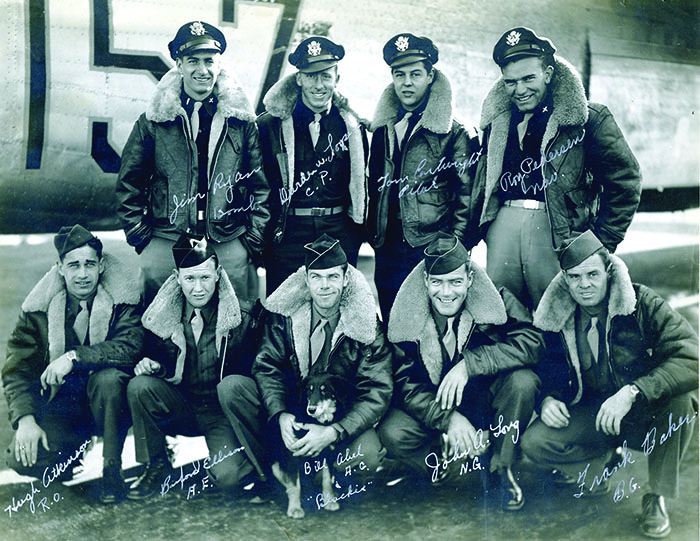
The Japanese blindfolded their prisoners and walked them five miles to the coastal fishing village of Yanai. “We could not see more than a bit of daylight from under our blindfolds,” Cartwright recalled. The police sat them in the town square. Throughout the night, Japanese civilians struck the Americans with their fists and wooden sticks; Cartwright heard angry women’s voices as they dealt the pair painful two-handed pinches.
The next morning, the Japanese military put the two men on a train. After half a day, the noise and traffic indicated they were now in a large city. In a cell at military police headquarters, Cartwright and Looper were reunited with the survivors of their crew. “I was elated to see that all our crew were there except for [tail gunner] Bill Abel and Roy Pedersen,” Cartwright said. There were also several other airmen who had been captured after the previous day’s mission, including two naval aviators. Although they were a dejected and ragtag group, Cartwright was relieved to see that no one was seriously injured. As the aircraft commander, he felt a deep sense of responsibility for his men and their well-being.
A Japanese officer with an English-speaking interpreter interrogated Cartwright. He began in a friendly manner, even offering him a cigarette, but became increasingly hostile. “He did not impress me as a trained interrogator,” Cartwright recalled. “When he got frustrated he would slap my hands, arms, or head with a swagger stick.” With American heavy bombing missions steadily destroying Japanese cities, the officer repeatedly asked why their city had not been bombed. Cartwright did not even know where he was. “I don’t know,” he replied.
“I know you’re not telling the truth,” the interrogator said, again striking Cartwright with the stick. “We’re going to send you where they will get the truth out of you.”
Once more blindfolded and shoved onto a swaying, clacking, slow-moving train, Cartwright began to feel sorry for himself. There had been at least some comfort in being with his crewmates. Now he was alone and scared. His guards sat in silence on either side of him, and he could tell whenever Japanese civilians boarded the train—they immediately stopped talking.
Unknown to Cartwright, he was en route to the Imperial General Headquarters in Tokyo. There, he was not allowed to speak to the men in adjoining cells or to even stand, except to use the waste bucket in the corner. His daily ration was a softball-sized rice ball and water. The Japanese interrogated Cartwright for three days. The next day, August 6, that abruptly changed, and Cartwright found himself kneeling on a drill field, blindfolded, head pushed down, his neck bared.
As he waited for the sword to drop and end his life, he listened to a Japanese officer orating to his troops. Abruptly, the man stopped speaking; guards jerked Cartwright to his feet and roughly led him back to his cell.
He remained there for days—until music suddenly began playing from loudspeakers previously used only for short, barking commands. “It sounded like funeral dirges to me,” Cartwright said. “I was apprehensive; my thought was that the emperor’s palace had been bombed and he had been killed and that would certainly bring retribution.”
After the music stopped, everyone listened attentively as a subdued voice spoke in monotone. Cartwright later learned that he had heard the Japanese national anthem, followed by Emperor Hirohito’s historic address of August 15, 1945, telling his people that the war was over.
The next day, a young guard brought Cartwright some dried fish with the rice ball. “The guard spoke some English and greeted me solicitously,” Cartwright recalled. “He said, ‘We will take you to a better place and soon you may be reunited with your parents.’”
Cartwright did not know if it was a promise of freedom or the threat of death.
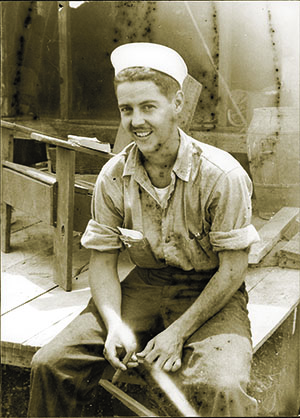
LATER THAT DAY, the Japanese moved Cartwright to Omori, a small island they had established as a POW camp. He was free to walk around the camp, where he met a variety of fellow POWs—Aussies, Brits, Canadians, New Zealanders, and Americans, including Lieutenant Colonel “Pappy” Boyington of the famed Black Sheep Squadron and Lieutenant Commander Richard O’Kane of the submarine USS Tang.
The POWs who had been there the longest were gaunt and starving; recent arrivals like Cartwright were in better condition. Cartwright’s bunkmate, a B-29 crewman who had been tortured and deprived of food, called him “Tarzan” simply because Cartwright was strong enough to jump down from his upper bunk, just four feet off the floor. No one knew anything more than Cartwright did about what had occurred in the past few days, but it seemed that the Japanese were capitulating. All doubt was removed a few days later when several American warships steamed gracefully into Tokyo Bay without any resistance.
On August 26 the prisoners at Omori woke up to find their captors had vanished. Later that morning, American transport planes flew over the island, dropping supplies by parachute, including toothpaste, razors, soap, rations, candy, coffee, and cigarettes. “The candy came down under an orange-colored chute and landed in the outdoor latrine,” remembered Cartwright. “I cut a piece of that chute as a souvenir.”
The mood was ecstatic. “In fact,” said Cartwright, “it was a bit wild. Colonel Boyington overdosed on caffeine and several of us took turns sitting up and talking with him the night through.”
Cartwright’s emaciated bunkmate asked for assistance in walking to a Catholic chaplain’s service. “His sermon was to not forget our war experiences when we got home,” Cartwright recalled, “but to not let memories of harsh treatment be an excuse for not contributing to society. This advice stuck in my memory.”
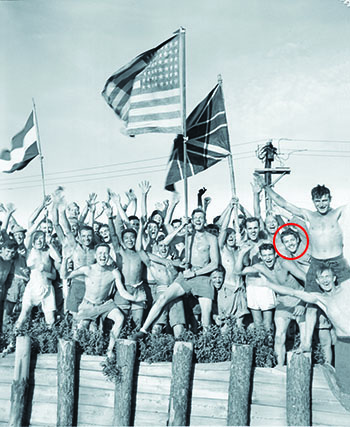
WHEN ADMIRAL William F. “Bull” Halsey heard there were POWs on Omori Island, not far from the American flotilla anchored in Tokyo Bay, he said, “These are our boys, go get them.” Within hours, Higgins boats approached the island. The prisoners heard the engines and many jumped into the water to swim out and meet them. “As landing barges moved toward shore, battle-hardened Marines saw emaciated Americans wading out into the surf, crying hysterically, sobbing out inarticulate greetings,” historian William Craig wrote in his 1968 book, Fall of Japan. “As they approached closer, the men in the boats wept, too.” In the famous photograph taken from the bow of the first Higgins boat, Cartwright is visible on the right, among the cheering throng of POWs.
MEDICAL PERSONNEL ABOARD the destroyer escort USS Reeves examined Cartwright; then he cleaned up and slept for 10 straight hours in a navy hammock. When he awoke, unlike many other emaciated POWs who could only manage a few bites of food, Cartwright stuffed himself with ham, mashed potatoes, and ice cream. Later, while talking to a civilian reporter and some naval personnel, Cartwright first heard about the new bomb dropped on Hiroshima.
He was on the hospital ship USS Benevolence on September 2, when Imperial Japan formally surrendered aboard the USS Missouri. Cartwright looked up in wonder as 462 B-29s and 450 carrier planes flew overhead, impressing upon the Japanese that the Allies were now in full control.
President Harry S. Truman demanded that POWs be the first Americans to come home after the war, so Cartwright was soon in a Douglas C-54 Skymaster, heading back to Yontan Airfield on Okinawa. As he made his way to 494th Bombardment Group headquarters, he was surprised no one recognized him—until he remembered he was wearing naval clothing. Once Cartwright established who he was, the men greeted him warmly and directed him to the 866th Bombardment Squadron headquarters in a nearby Quonset hut.
As Cartwright walked in, a man bent over a sheet of paper with a pen in hand looked up and froze. “I literally interrupted an officer who had been laboring over a condolence letter to my parents,” Cartwright said.
SHORTLY AFTER HE RETURNED TO OKINAWA, Cartwright was overjoyed to encounter his tail gunner, Bill Abel. After parachuting out of their doomed aircraft, Abel had hidden in a hollowed-out tree for nine days. Starving, he had finally turned himself in and had been held at a POW camp in Yokohama.
When he returned home in October 1945, Cartwright began investigating the fate of the rest of his crew but found no details. After studying written accounts and photographs of Hiroshima, together with his own recollections, he became convinced that his crew had been held in that city—and killed by the atomic bomb.
Nearly 60 years later, in his memoir A Date with the Lonesome Lady: A Hiroshima POW Returns, Cartwright wrote, “Whenever I thought of the meeting with Bill Abel back on Okinawa, shaking hands and hugging spontaneously over and over, thinking that the rest of our crew, our buddies, were on their way—just hadn’t gotten there yet—I would choke up and my eyes would get misty, just as they are as I write this.”
A HIGH-LEVEL TARGETING COMMITTEE in Washington, DC, consisting of military officers and scientists, had chosen Hiroshima as the primary target for the Little Boy atomic bomb because there were no known POW camps reported in the city and it was a major naval center with several military headquarters. Additionally its flat geography and predominantly wooden architecture would maximize the destructive power of the bomb. The target itself was the distinctive T-shaped Aioi Bridge, located just a half mile from where Cartwright’s crew was held.
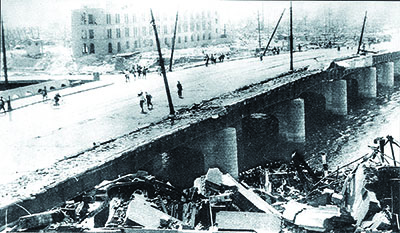
Cartwright’s belief that navigator Roy Pedersen died after bailing out was confirmed in 1997, when a decades-old Japanese police report from a nearby town confirmed that Pedersen’s parachute had failed to open. Copilot Durden Looper, bombardier James Ryan, nose turret gunner John A. Long, and flight engineer Buford Ellison were presumably killed in Hiroshima, along with several other captured Army Air Forces and navy airmen, when the atomic bomb exploded 1,900 feet above ground at 8:15 a.m. on August 6, 1945. Waist gunner/radio operator Sergeant Hugh Atkinson may have been one of the reported two POWs who survived the explosion, only to perish soon afterward when enraged Japanese civilians tied the pair to a pole on Aioi Bridge and beat them to death. Ball turret gunner Staff Sergeant Ralph J. Neal and navy dive-bomber crewman Norman R. Brissette survived the atomic bomb firestorm by diving into a cesspool, but both men agonizingly died two weeks later from radiation poisoning.
If Cartwright had been more convincing to his initial interrogator, he may have been with his crewmates in Hiroshima that fateful morning. Many years later, he wrote, “When I was blindfolded, escorted to a drill field, pushed to my knees with my head down, I did not have feelings of panic. I knew from that time on that I could face death with equanimity. After that experience, when the harassment had stopped and I sat in my solitary cell, I decided that what I wanted to seek in life was, first, to marry my sweetheart when I got home and, second, to become a peaceful farmer. I accomplished the first and came close to the second.”
Lucky indeed. ✯

